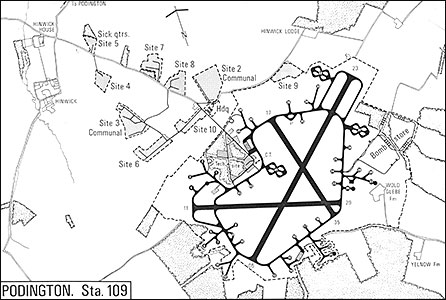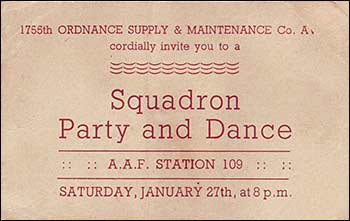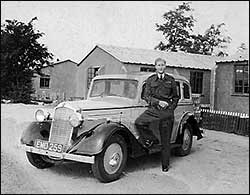|
||||||||||||||||||||||||||||||
| A History written for a reunion, Anon. |
||||||||||||||||||||||||||||||
|
Podington Air Base
|
||||||||||||||||||||||||||||||
|
A A F 109
|
||||||||||||||||||||||||||||||
|
||||||||||||||||||||||||||||||
| It must have been formidable for the intrepid American Airmen to arrive in England at war. Even in peace time, Podington in Bedfordshire is off the beaten track. In war time with road signs gone and a blackout it must have been like the other side of the moon, they even had to drive through Moonshine Gap. Podington airfield was a slice of rural Bedfordshire flattened and denuded to create vast concrete runways for the war time air base, with barracks and hangars hiding in the surrounding trees that had not been cut down. The 92nd is the oldest serving group in the American Air Force, and during World War Two flew 308 missions over enemy territory, sadly with the loss of many young lives. Also during the first Schwienfurt raid on the ball bearing works (a raid that went badly wrong for the 40th Combat Wing), the lead aircraft was from Podington, piloted by James "Kemp" McClaughlin (Captain), the Bombardier being Harry Hughs. Both have since returned to the village during the reunions, and their account of this action can be found in the book "Castles in the Air". The 92nd boast of many actions of bravery; one such action was by 2nd Lt. John C Morgan, co-pilot. The Pilot, 1st Lt. Robert L Campbell, had been hit, his head shattered and dying. Morgan struggled for two hours to keep him away from the controls of the stricken plane. Flying the aircraft with no hydraulics, he kept the plane in formation and dropped the bombs on target, flying the plane one-handed. The top turret gunner, Tyre Weaver, his arm severed at the shoulder, and with no medical attention possible, was safely put out of the plane by 2nd Lt. Kath Koske, putting his own 'chute on him. He survived the war, being picked up by German troops and properly treated. John Morgan brought the plane back, landing in Southern England, with all controls hardly usable. He was decorated with the highest award for his brave actions. The group left Podington in 1945, a few came back at different times, but on18 May 1985 many came back for the dedication of a Memorial to them. The group paid for the restoration of the Church organ, the cost being in excess of £7,000. An inscription is on the side of the organ, above the propeller blade from one the B17s from the base. The group came back again when the American flag was dedicated in the Church, and which is sited next to the organ. The village has made many friends among the 92nd veterans, they consider Podington a place where they can visit and always be welcomed, and hold the village and villagers very dear to their hearts. To quote John Shorrock, an ex-crew chief at the base: "It's a wonderful feeling to come to England to be loved by a whole village for four days". I sincerely hope the airfield, and the brave young men who served, fought and died there, will always remain part of the history and heritage of the village of Podington. "War is evil, but the good that came from the evil of war shows itself, certainly in the village of Podington". The Americans who came to Podington were the 92nd Bombardment Group of the Eighth Air Force and they flew B-l7s - Flying Fortresses. They brought everything with them, hospital and food supplies, they had to as everything in England was in short supply. They brought more - they brought their outgoing friendliness and even more concrete - - nylons! Now here is the outstanding history of the Group from its formation on 1st March 1942 at McDill and Sarasota Fields in Florida where it trained with the B-17s. The Group arrived in England in July 1942, being stationed initially at Bovingdon, Herts., and was assigned to the Eighth Air Force. After flying combat missions in September and October 1942 it trained replacement crews. In May 1943 it began the bombardment of strategic objectives which continued throughout the war. These missions were flown at first from Alconbury, Hunts, but in September 1943 the Group moved to Podington. Some of the targets were Kiel shipyards, Schweinfurt ball-bearing plants and the submarine installations at Wilhelmshaven, a tyre plant at Hanover, airfields near Paris, an aircraft factory at Nantes and a magnesium mine and reducing plant in Norway. Although handicapped by weather, enemy fire and insufficient fighter protection, the Group bombed aircraft factories in central Germany on the 11th January 1944 and received a Distinguished Unit Citation for the mission. During Big Week, 20-25 February 1944, the 92nd took part in the intensive bombing campaign against the German aircraft industry. Then it attacked V-weapon sites in France, airfields in France, Germany and the Low Countries, and industrial targets in France, Germany and Belgium, making concentrated strikes on oil and transportation facilities after October 1944. In addition to strategic missions the Group performed interdictory and support operations. Then it operated in support of the Normandy invasion in June 1944 by hitting gun emplacements, junctions and marshalling yards in the beachhead area. During the breakthrough at St. Lo in July 1944 the Group supported the ground forces. On the airborne assault on Holland in September 1944 it bombed bridges and gun positions. Then in December 1944 to January 1945 in the Battle of the Bulge it attacked bridges and marshalling yards. In March 1945 the group bombed airfields near the landing zone to cover the airborne assault across the Rhine. In June 1945 it moved to France and transported troops from Marseilles to Casablanca for the return to the U.S. Finally the group was de-activated in France on 28 February 1946.
Claims to Fame 1. Oldest Group in Eighth Air Force. 2. Pioneered non-stop Atlantic flights to United Kingdom. 3. 327th Bombardment Squadron the only USAAF unit equipped with YB-40s (B-l7 "gunship"). 4. Flew Disney rocket bomb experimental missions. 5. Organized and manned 1/11th combat crew replacement centre at Bovingdon 1942-43. 6. Led Eighth Air Force on last mission of war. 7. Medal of Honor, Flight Officer John C. Morgan. Flight Officer John C. Morgan, co-pilot, received the Medal of Honor for action aboard a B-17 during a mission over Europe on 26 July 1943; when the aircraft was attacked by enemy fighters the pilot suffered a brain injury which left him in a crazed condition; for two hours Flight Officer Morgan flew in formation with one hand at the controls and the other holding off the struggling pilot who was attempting to fly the plane: finally another crew member was able to relieve the situation and the B-17 made a safe landing at its base. MAJOR AWARDS Distinguished Unit Citation 11 January 1944 All these are facts of the brilliant and dangerous work of flying these great bombers to damage and break the enemy's war effort. What about the airmen's lives when not in action? Uprooted from their homes and families, what could rural Bedfordshire offer? A great friendliness grew up with the locals, many of whom invited the G.I.s and Officers into their homes, whilst the Americans entertained them in the camp, especially giving Christmas parties to the children. Some of the local people worked at the camp and were transported by truck to and from their homes. The American Red Cross Aero Club especially needed and received help. Many people must have been very sorry to see the departure of the G.I.s and many close ties must have been broken, but the Americans must have felt satisfaction in a job well done and be glad to get back to their homes again with much to tell. |
||||||||||||||||||||||||||||||
|
A visit in 1944 Wm Abington
|
||||||||||||||||||||||||||||||
|
||||||||||||||||||||||||||||||
If you have any memories or pictures to share with us please contact us Bedfordshire Villages Index |
||||||||||||||||||||||||||||||


